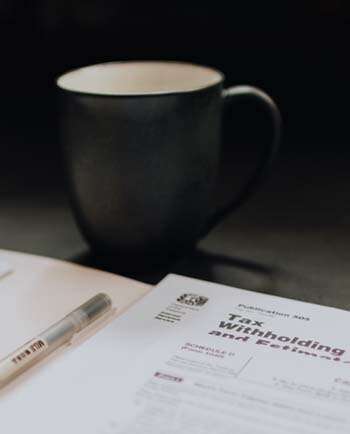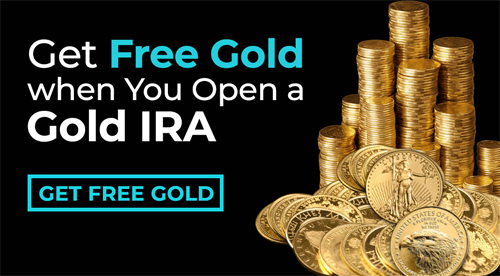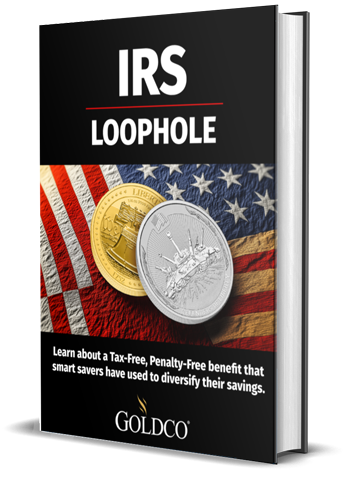Thank you for visiting our gold IRA tax rules ultimate guide (updated for 2025). In this article, we’ll explain everything you need to know about how gold is taxed in an IRA and popular bullion to include in your gold IRA. We’ll also cover the most common FAQs about gold IRAs and taxes.
Feel free to use the quick links in the TOC list to jump straight to any section:
Gold IRA Tax Rules: Introduction
Can you add physical precious metals to your retirement account? Contrary to common belief, precious metals IRA investments are neither disallowed nor discouraged by the Internal Revenue Service.
Certain criteria need to be met, however.
 While the self-directed IRA allows you a lot more freedom to invest as you please, you can neither administer custody nor storage of the individual retirement account.
While the self-directed IRA allows you a lot more freedom to invest as you please, you can neither administer custody nor storage of the individual retirement account.
Unless you happen to have an IRS-approved bullion depository and are a custodian by trade, you’ll have your account managed and your bullion stored by third parties.
More often than not, this is mediated by what are known as gold IRA companies, which usually provide the bullion for the retirement account as well.
From there, a somewhat similar set of tax rules applies to the gold IRA as it might to any other retirement vehicle of the sort. This includes regulations pertaining to funding, withdrawals as well as the inheritance of an IRA, whether by you or someone else.
>>> Get Free Gold When You Open a Gold IRA!
Firstly, let’s dive into what the IRS considers acceptable physical precious metals for inclusion in an IRA.
What Precious Metals Are IRA-Eligible?
For the most part, the metals in a gold IRA are going to be decided by their purity. In the case of all four precious metals, whether they can become part of an IRA is related to the amount of precious metals content they have.
Specifically, the rules for each metal are:
- Gold bullion should have a minimum of 0.995 purity
- Silver bullion should have a minimum of 0.999 purity
- Platinum should have a minimum of 0.9995 purity
- Palladium should have a minimum of 0.9995 purity
Including items that are in violation of this requirement can cause penalties and account liquidations, so the buyer should always be wary.
When working with a reputable gold IRA company and custodian and procuring bullion from them, this will rarely be an issue, as they’ll provide advice on what can and can’t be included.
Another important criterion is that the bullion rounds and bars of any of the four precious metals come from a COMEX or NYMEX-approved refinery. This essentially means that only bullion made by reputable mints, whether sovereign or private, is eligible for an IRA.
Most mints of this kind produce rounds and gold bars exclusively with these certificates and specifically label their products as IRA-eligible, so you are unlikely to run into issues when purchasing from recognizable names.

Popular Precious Metals Coins And Bars To Include In A Gold IRA
Here are some popular coin choices for a gold IRA:
 Gold
Gold
- American Gold Eagle bullion and proof, due to an exception
- American Buffalo bullion
- Canadian Gold Maple Leaf bullion
- Australian Kangaroo bullion
- Austrian Gold Philharmonic bullion
 Silver
Silver
- American Silver Eagle bullion and proof, due to an exception
- Australian wildlife and Lunar bullion silver coins
- Canadian Silver Maple Leaf bullion
- Austrian Silver Philharmonic
 Platinum
Platinum
- American Platinum Eagle bullion and proof, due to an exception
- Canadian Platinum Maple Leaf bullion
- Australian Platinum Koala bullion
- Isle of Man Noble coins
 Palladium
Palladium
- American Palladium Eagle bullion and proof, due to an exception
- Canadian Palladium Maple Leaf bullion
Collectibles
You probably noticed that we mentioned an exception in the case of every American Eagle coin, and you might be familiar with the “no collectibles” rule for a self-directed IRA. In reality, this rule remains somewhat murky even after all these years.
The American Eagle is the only coin to have an explicit exception mentioned for both bullion and proof, undoubtedly because it is the national legal tender.
This not only means that American Gold Eagle bullion gold coins that do not meet the purity requirements are eligible but also that proof and uncirculated versions of them can go in.
Any proof coin is generally considered a collectible, which would automatically exclude it from eligibility. On the other hand, eligibility is decided by purity, which coins like the American Buffalo meet.
Many bullion shops will not sell coins such as the proof American Buffalo to an IRA because they are unsure of how the IRS treats them. These coins aren’t normally included in an IRA even though they fit the guidelines to “stay on the safe side.”
In other words, the only proof coins you should feel comfortable adding to your precious metals IRA until greater clarity is presented are American Eagles.
Gold IRA Tax Rules On Withdrawals
 You might have heard that there are 2 main types of retirement accounts for the storage of precious metals: Traditional IRA and Roth IRA.
You might have heard that there are 2 main types of retirement accounts for the storage of precious metals: Traditional IRA and Roth IRA.
Each has its benefits and drawbacks depending on your preferences and how you plan to manage your IRA down the line.
While the newly-created self-directed IRA will have to be assigned one of these 2 types, you can use any number of Traditional or Roth IRAs to fund it, as well as other employer-sponsored plans.
1. Traditional IRA
The Traditional IRA has the benefit of being tax-deductible and the drawback of imposing penalties on early withdrawals.
What does each mean?
In the case of the first, contributions to the IRA are sometimes referred to as pre-tax. In other words, money funded with it is taken off what would normally be your annual taxable income.
In return, the money you withdraw from the IRA will be subject to taxation on annual gross income. Withdrawals from a Traditional IRA generally shouldn’t happen before age 59 ½, as doing so incurs an early 10% penalty on top of the tax you’ll be paying down the line.
As in the case of the Roth IRA, an early withdrawal can be made without this penalty in the case of a “necessity”, such as a first home or health insurance for an unemployed account owner.
It’s also noteworthy that a Traditional IRA requires you to begin taking out distributions by age 70 ½ or face a 50% tax on the designated annual amount you were meant to withdraw.
Who the Traditional IRA is ideal for: Those looking to treat their retirement account as a better or more stable pension fund, one that invests in precious metals and is overseen by you and the people you’ve assigned.
>>> Get Free Gold When You Open a Gold IRA!
2. Roth IRA
While it shares the aforementioned necessity exception, a Roth IRA is the opposite of the Traditional variety in several ways.
Contributions to the Roth IRA aren’t tax-deductible: they are treated as an investment and subject to an earnings tax unless you are older than 59 ½ or have an account that is over five years old.
With a Roth IRA, you can withdraw funds before the age of 59 ½ without incurring the 10% penalty. When you retire, the withdrawals you make won’t be subject to any taxation. That also means the assets in this IRA are exempt from a capital gains tax.
Another benefit of the Roth IRA is that it doesn’t force you to begin taking distributions by age 70 ½, giving you more flexibility. This doesn’t apply to those inheriting a Roth IRA, however, as beneficiaries have to either take a distribution or roll the IRA into a new account.
Who the Roth IRA is ideal for: Those looking for a tax-advantaged investment portfolio more so than a pension fund, and those who might need to take out early distributions from their retirement account for whatever reason.
For more details, visit our article Gold IRA Rules: How To Protect Your Retirement With Precious Metals.
Beneficiaries: Inheriting An IRA
Here, the Roth IRA again emerges as the superior choice in regard to taxation. Those who inherit a Roth IRA can withdraw gold and other precious metals from it without taxation, while beneficiaries of a Traditional IRA will have to pay taxes on withdrawals.
Withdrawals can be made from an inherited IRA from someone who passed away before age 59 ½ without incurring the 25% penalty (2025 update). Account maturity remains an important consideration, however, as inherited Roth IRAs should ideally be older than 5 years to avoid penalties.
Additionally, you have a considerable, though not total, degree of lenience when choosing how to withdraw the precious metals in the inherited IRA. You can roll the account over, withdraw the physical precious metals, or liquidate them and get cash instead.
However, a general 5-year period is given within which all of the funds in an inherited IRA should be withdrawn by the beneficiary.
This period can be prolonged, often considerably, depending on the previous owner’s age, your age, your relationship with the benefactor, and other factors. For more clarification on whether the period can be extended, it’s best to talk to the IRS itself or a tax advisor.

Gold IRA Tax Rules FAQs
How is gold taxed in an IRA?
The tax rules for your IRA will depend on whether you’ve picked a Traditional or Roth IRA as well as your income bracket, the latter being another important consideration.
Those with a Traditional Gold IRA pay an income tax after they begin taking out distributions, while those with a Roth IRA pay it similarly to how they would pay taxes on any other investment.
Notably, gold investments in an IRA are exempt from the 28% collectible tax rate unless the IRS deems the bullion in your IRA to be in violation of the “collectibles” guidelines.
Is gold IRA tax-free?
Only a Roth IRA you’ve inherited is considered “tax-free”. Those who inherited a Traditional IRA pay taxes when they make a withdrawal, and they are generally expected to make a full withdrawal within 5 years.
Both owners of Traditional and Roth IRAs pay taxes on their account, just in different ways: in the simplest of terms, a Roth IRA taxes you up-front or as you go, while a Traditional IRA taxes you once you retire.
Can I take physical possession of the gold in my IRA?
Owners of gold IRAs can’t store the bullion in their IRA on their own while the account is active under any circumstance unless they happen to have a bullion depository. Whether you inherited a gold IRA or own one, you can take some or all of the bullion out of it whenever you want.
However, if you’ve taken some of it, it will count as a distribution and you will be taxed based on the factors outlined above. If you take out all of the gold, depending on what else the IRA contained, the account might be emptied and therefore liquidated.
In general, however, the physical gold in the IRA is available to you at any point if you’re willing to pay the distribution penalty.
How do I avoid capital gains tax on gold?
Always consult with your tax professionals before buying or selling any precious metals to ensure there are no surprises coming in tax-filing time.
As outlined above, gains and withdrawals in a Traditional IRA are taxed as ordinary income. In the case of the Roth gold IRA, the capital gains tax is pretty much eliminated.
It’s not without reason that precious metals IRAs have proven to be an exceedingly popular way of investing in gold.
What are the contribution limits for a gold IRA?
The annual contribution limit for IRAs remains at $7,000 for 2025, with a catch-up contribution limit of $1,000 for those 50 and older.
What are the income limits for a Roth IRA?
The income limit for contributing to a Roth IRA in 2025 is $150,000–$165,000 for singles and heads of household, and $236,000–$246,000 for married couples filing jointly.


 Gold
Gold Silver
Silver Platinum
Platinum Palladium
Palladium


